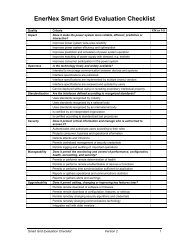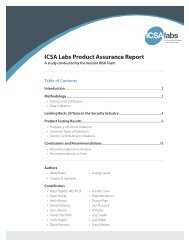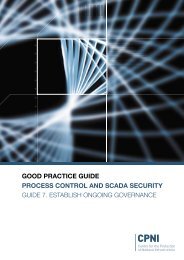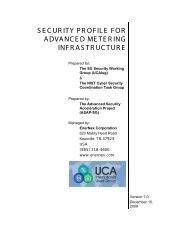security profile for openadr - Open Smart Grid - OpenSG - UCA ...
security profile for openadr - Open Smart Grid - OpenSG - UCA ...
security profile for openadr - Open Smart Grid - OpenSG - UCA ...
You also want an ePaper? Increase the reach of your titles
YUMPU automatically turns print PDFs into web optimized ePapers that Google loves.
2 176 Functional Analysis<br />
177<br />
178<br />
179<br />
180<br />
181<br />
182<br />
183<br />
184<br />
185<br />
186<br />
187<br />
188<br />
189<br />
190<br />
191<br />
192<br />
193<br />
194<br />
195<br />
196<br />
197<br />
198<br />
199<br />
The purpose of the functional analysis is to define a clear picture of the scope,<br />
architecture, and functionality of <strong>Open</strong> Automated Demand Control (<strong>Open</strong>ADR)<br />
systems, as addressed by this <strong>security</strong> <strong>profile</strong>. The implementation of <strong>Open</strong>ADR system<br />
functions varies in terms of function, scope, and technology from among different market<br />
and system offerings and deployments. However, this <strong>profile</strong> approaches the problem by<br />
defining a set of abstract roles that capture essential functionality that may be realized<br />
through a variety of implementations. This <strong>profile</strong> defines roles in such a way that the<br />
logical architecture and use case functionality may be used to represent a wide variety of<br />
real-world implementations.<br />
By way of background, the following steps were per<strong>for</strong>med in the functional analysis:<br />
1. Review of the existing documents that define the overall <strong>Open</strong>ADR process,<br />
paradigm, and design (as defined in Appendix E References).<br />
2. Define abstract roles that characterize elements of <strong>Open</strong>ADR Systems. Roles are<br />
neutral to implementation and vendor, and capture the essence of common<br />
functionality without the details of particular applications. The resulting roles are<br />
presented in Section 2. Their relationships with each other (topologically) are<br />
presented in Section 2.1.<br />
3. Define use cases describing how the roles interact to implement <strong>Open</strong>ADR<br />
functionality. The use cases are modular in nature, which allows organizations to<br />
determine which use cases are relevant to their deployments. They also capture<br />
raw functionality, without the inclusion of <strong>security</strong> controls, which ensures that no<br />
pre-existing <strong>security</strong> controls are assumed and allows different controls to be<br />
applied without bias. The resulting use cases are presented in Section 2.4.<br />
SECURITY PROFILE FOR OPENADR<br />
Version – 0.02<br />
<strong>UCA</strong> International Users Group December 15, 2011<br />
16









